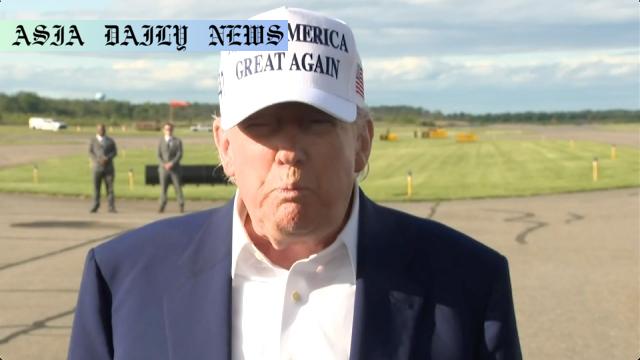US Steel: Trump ensures American control in Nippon Steel deal.
US President Trump assured American control over US Steel amidst Nippon Steel’s partial ownership investment deal.
Trump called Nippon Steel a ‘very good company’ but emphasized American leadership in the collaboration.
The decision remains pending as Trump weighs the final deal before the June 5 deadline.

US Steel and Nippon Steel Deal: A Strategic Alignment
US President Donald Trump’s recent remarks about the strategic partnership with Nippon Steel have sparked discussions among investors and diplomats worldwide. Trump addressed media inquiries on Sunday, emphasizing that while Nippon Steel will have partial ownership in US Steel, the overall control of the American steel giant will firmly remain in US hands. This statement signifies the administration’s cautious approach to ensuring national interests are prioritized while navigating international collaborations and investment partnerships.
Nippon Steel, a globally esteemed Japanese steelmaker, has expressed interest in acquiring a partial stake in US Steel, aligning with economic ambitions on both ends. Trump has described Nippon Steel as a “very good company,” signaling a mutual respect and acknowledgement of its robust reputation within the global steel industry. The president also referred to the arrangement between the two companies not as a takeover but rather as a planned “partnership,” aimed at boosting economic cooperation and steel production stability while maintaining US dominance in key sectors.
Broader Implications for the American Steel Industry
The American steel sector, a cornerstone of the country’s industrial backbone, has faced significant competition from global players in recent years. This potential deal, which awaits President Trump’s formal approval by June 5, signifies not only an economic collaboration but also a strategic move to bolster steel manufacturing capabilities within the US. Trump’s firm stance on maintaining “American control” over the deal acts as a reassurance to industry stakeholders and political allies concerned about foreign ownership over critical manufacturing assets.
Furthermore, this partnership could pave the way for technological sharing and infrastructure enhancements, benefiting the domestic steel supply chain. With Nippon Steel’s renowned production methodologies and research expertise, combined with US Steel’s established footprint in the American market, both companies could achieve a symbiotic relationship that fosters innovation, growth, and global competitiveness. Such initiatives prove critical in revitalizing an industry that has been struggling with declining profit margins and global trade challenges.
The Road Ahead: Questions and Uncertainties
Despite the budding optimism surrounding this partnership, questions remain unanswered regarding the specific terms and structure of the deal. For now, investment analysts, economists, and industrial leaders await further specifics about equity distribution, decision-making powers, and governance structures between the two companies. The president mentioned “we’ll see” when probed for additional clarity, suggesting ongoing negotiations and deliberations before the June 5 decision deadline.
As Bloomberg reported, the ambiguity of Trump’s initial endorsement continues to leave investors, executives, and diplomats uncertain about the practicalities of this partnership. Clearer communication and structured planning will be essential to ensure alignment among all stakeholders. The final agreement must balance economic opportunity, security concerns, and strategic goals to demonstrate thoughtful leadership in shaping America’s industrial future.
Conclusion: A Deal with Future Implications
The potential collaboration between US Steel and Nippon Steel represents a step toward a more interconnected global economy while preserving national interests. While the president’s remarks have provided reassurance about maintaining US control, the specific components of the partnership will determine its ultimate success and broader implications for the steel industry. With Trump’s pending decision on June 5, an eventual policy declaration will mark a critical moment for the economic and industrial landscape in America.
Commentary
Balancing Economic Collaboration and National Interests
The potential partnership between US Steel and Nippon Steel marks a fascinating development in the global economic narrative. President Trump’s strong emphasis on ensuring American control speaks volumes about his administration’s commitment to protecting national interests while fostering foreign investment opportunities. It reflects the delicate balancing act of satisfying both domestic and international pressures, a challenge often faced by leaders in a globalized economy.
By affirming that the deal is not a full takeover but rather an investment with “partial ownership,” Trump opens the door for beneficial collaboration without compromising control over a vital sector. Nippon Steel’s inclusion could introduce innovative technologies and new perspectives that boost productivity and growth within the US steel industry. However, it is equally essential to ensure the partnership does not result in dependency or loss of strategic autonomy for American stakeholders.
Questions About Transparency and Long-Term Strategies
While the president’s reassurances are welcome, many pertinent details remain unclear. What exact percentage of ownership will Nippon Steel hold? How will decision-making and governance structures be distributed? These lingering uncertainties make it difficult to gauge the long-term implications of the partnership. Transparency in negotiations and communication will be critical in alleviating concerns among American investors, steel industry workers, and political observers.
Additionally, the rapidly approaching June 5 deadline for Trump’s decision may further pressure both parties to finalize terms without leaving room for detailed public discourse or feedback from key stakeholders. It becomes critical for the administration to weigh the economic benefits alongside potential risks, ensuring that the deal aligns with broader policy goals for industrial resilience and economic independence.
Looking Ahead: Economic Revival or Missed Opportunity?
This partnership, if executed thoughtfully, could serve as a blueprint for future collaborations between domestic industries and international investors. By integrating Nippon Steel’s expertise with US Steel’s local presence, the deal could unlock significant potential for innovation and efficiency. However, hasty agreements or insufficient planning could lead to missed opportunities or unintended consequences, such as dependency or diminished US competitiveness.
Ultimately, the final outcome of this negotiation will highlight whether the administration can strike a harmonious balance between collaboration and autonomy. As key sectors like steel continue to face global pressures, fostering partnerships that support innovation, economic growth, and strategic independence will be instrumental in defining America’s industrial trajectory for years to come.


